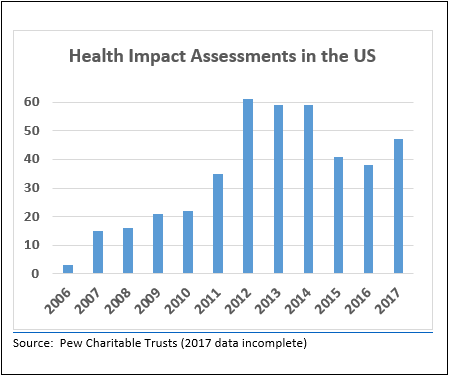- About Us
- Events & Training
- Professional Development
- Sponsorship
- Get Involved
- Resources
Why is Everyone Talking about Health Impact Assessments?Submitted by Paula Reeves, AICP CTP Our policymakers, community leaders, and the residents of our communities have come to understand that health is not created in the hospital or at the doctor’s office. Public health and quality of life largely depend on a combination of lifestyle, behavior, social factors, and the places where we live (60% or our health status). Transportation systems, food access, housing, workplaces, and the decisions we make in planning them directly impact our health. A Health Impact Assessment (HIA) is really a planning process that helps support the required review and analysis of potential health effects of a project, plan or policy before it is built or implemented. An HIA can also provide mitigation recommendations to improve health outcomes.
In Washington, there have been about 15 HIAs conducted in both large and small communities to date on topics ranging from industry or transportation to comprehensive plans. Funding opportunities for HIAs have also increased, both public and private. Even APA Washington has gotten into the funding act through a 2016 partnership with the American Public Health Association of Washington to secure funding through National APA and the Centers for Disease Control. What is the legal foundation for Health Impact Assessments? A recent report from the Pew Charitable Trusts inventories HIA practices and concludes, “Only Washington’s law explicitly calls for an analysis of health impacts as part of the EIS process.” -Wash. Admin. Code § 197-11-440 Both the Washington State and the National Environmental Policy Acts (40 C.F.R. 1508) call for the review and analysis of the direct, indirect, or cumulative impacts of a proposed action on public health and safety as well as other factors. A primary stated purpose of the State Environmental Policy Act (RCW 43.21C.010) is to stimulate the health and welfare of human beings. Additionally, Local Health Jurisdictions in Washington have the ability to call for special studies or other actions necessary to maintain public health and safety under state law (RCW 70.05). A Planner’s Perspective… Planning and public health professions have always been intertwined. The HIA process presents a tested process to apply when community interests are running high and additional analysis and public input are desirable for plans, projects, and policies we are developing or updating. There is a lot of support for Planners interested in conducting an HIA. I can attest to that as I sit in my new job at Washington State Department of Health (DOH) surrounded by Toxicologists, Epidemiologists, Public Health Attorneys and other health experts. DOH offers community assistance on three types of HIAs.
|

 Since 2006, HIAs have increased nearly 20 fold across the US making them the fastest growing type of planning currently underway. This makes sense when you think about the growing public interest in personal and community health.
Since 2006, HIAs have increased nearly 20 fold across the US making them the fastest growing type of planning currently underway. This makes sense when you think about the growing public interest in personal and community health.  Some Additional HIA Resources:
Some Additional HIA Resources: